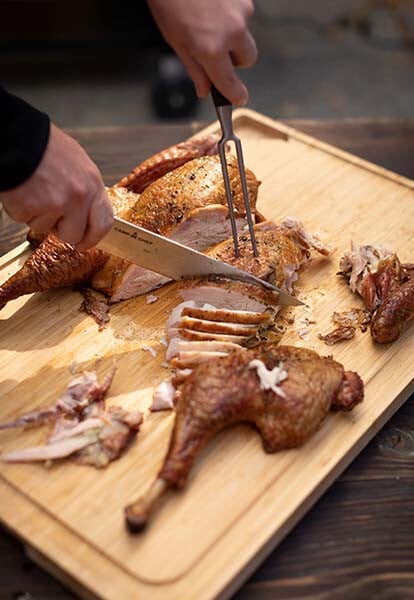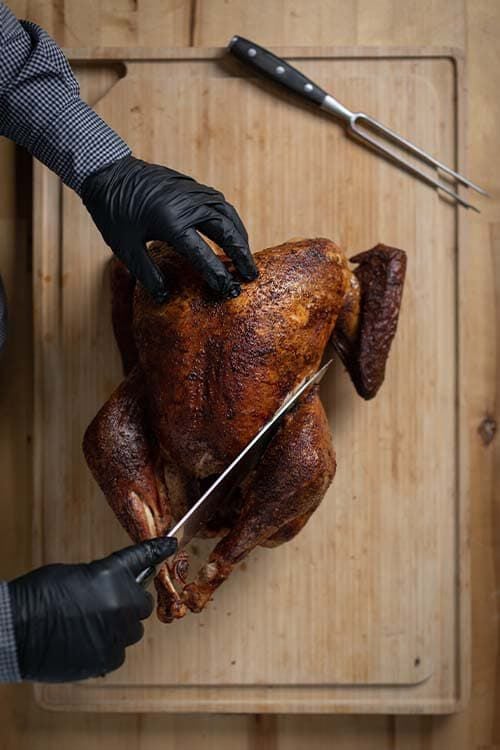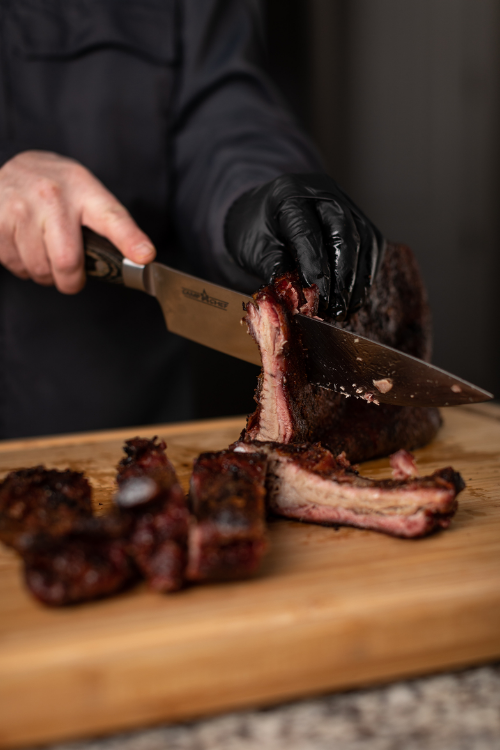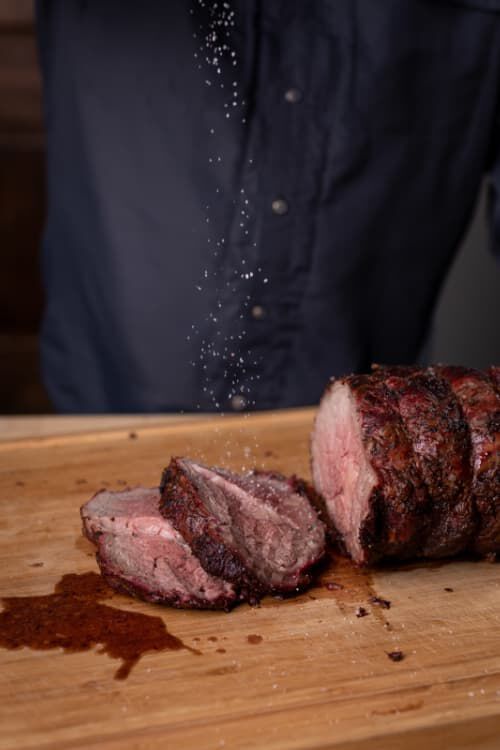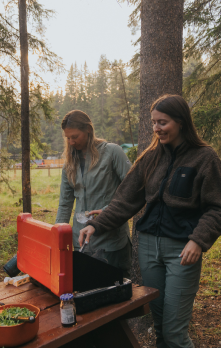What does Brining do to a turkey?
Brining simply means to soak your turkey in a water and salt solution (the brine).There are actually two different kinds of brines which we will discuss but most common is the wet brine. The other is a dry brine that is similar to seasoning the turkey a day in advance and letting it sit on the meat and skin. When talking about a wet brine often, other ingredients are added to the brine, such as sugar, molasses, honey or corn syrup. The purpose of a brine is to produce a more tender and flavorful turkey.
According to research published in the Journal of Food Science, the salt in the brine dissolves a bit of the protein in the muscle fibers, and allows the meat to absorb the brine and retain moisture during cooking. This makes the poultry juicier, more tender and improves the flavor. There is no shortage of brine recipes, but in order to reap the benefits of brining, you must use the following safe steps.
Should I wet brine or dry brine a turkey?
WET BRINE VS. DRY BRINE
Pick your poison—well not really. Either method is good. Brining is basically a fancy word for adding flavor...similar to seasoning a turkey. Here's a little breakdown of our findings on if you should wet brine or dry brine your turkey.
DRY BRINING
Dry brining is kind of like a smoked turkey rub. It consists of rubbing the salt and seasonings directly onto the meat and skin. Then letting it rest for a period of time. This process will typically take between 24-72 hours, 2-3 hours / pound.
Pro: Simple and requires less space than wet brining. The salt helps keep the turkey moist and adds flavor.
Con: Requires more time when done right.
WET BRINING
Wet brining consists of submerging the turkey in salt, spices, and water for an extended period of time. This process will typically take between 12-24 hours.
Pro: Infuses both flavor and moisture.
Con: Requires a large container for the turkey, or a durable brine bag which can take up more space in the refrigerator.
What should I put in a brine?
Dry brines are easy. All you need is some salt, and seasoning. Try to get some under the skin to directly absorb into the meat but make sure to leave a nice dusty coating on the skin. This will help with having a crispy skin. On the other hand a wet brine allows you to be very creative. It is common to add citrus like oranges and lemons to the mixture. You can also add carrots, celery and other aromatics like thyme, sage, garlic, bay leaves, and almost anything else you would like to add. With a wet brine the mixture is very diluted with the amount of water so feel free to liberally add in flavors. You don't have to worry about over powering the bird with flavor in a wet brine.
How long should I brine a turkey?
The time of how long your turkey should brine for depends on the size of the turkey and the type of brine you decided to go with. A good dry brine should sit for 24-72 hours. A good wet brine only needs 12-24 hours. This is all flexible because we have not factored in the size of the bird. Larger birds will need to be on the longer end of those spectrums and smaller birds can be done on the shorter end. Letting a turkey sit in a brine too long can actually start to be counter productive. The turkey can absorb too much salt and will now have a very salty taste no matter what you do. It can also break down and start to have a spongy texture. In this instance longer isn't always better. Stick with the general times listed above and you will be fine.
What is the best way to cook a turkey?
Best is a subjective term. What I think it best may not be what you think its best. Do you want the fastest? What about the crispiest skin? Do you want smoky flavor or something you can cook in your house? We will try to lay out everything you need to know about the different way to cook a turkey so you can decide what "best" is. Here is a general guide to how long a turkey takes to cook.
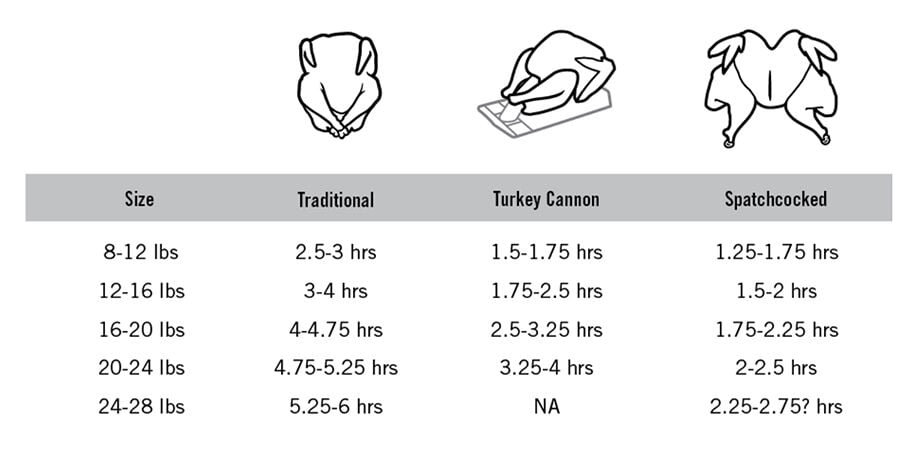
The internal temperature to safely consume turkey is 165°F. The most accurate way to monitor your turkey's cooking progression is by using a meat probe or thermometer. Keep in mind to also check different part on the turkey. Dark meat tends to cook faster which can be deceiving as to if the breast is safe to eat or not.
Deep Frying a turkey
Deep frying a turkey is another popular cooking method that is worth mentioning. You’ll need an adequately large, yet safe pot and cooker to start. We sell one here on the website. Many of the poultry preparation steps are the same, however, you use cooking oil to cook your turkey all the way though. Many people choose this method to get a juicy inside and a crackly, crispy skin. There are pre-cautions that you need to make note of before settling on deep frying a turkey. For a safe and delicious recipe check out our Deep Fried Thanksgiving Turkey recipe.
WARNING
- Please read and follow the appliance instruction manual included with your Turkey Fryer.
- Do not cook a turkey weighing more than 18 LBS. Failure to follow this instruction will cause oil overflow.
- Do not let your oil exceed 400°F
- Never drop food or accessories into hot cooking liquid. Lower food and accessories slowly into the cooking liquid in order to prevent splashing or overflow
- Do not operate the Turkey Fryer under ANY overhead construction. Keep a minimum clearance of 10 FT from the sides, front and back of appliance to ANY construction.
What oil should I use?
There is a number of different oils you can you. Surprisingly oil can be very different depending on what you get. What you want for deep frying a turkey is an oil with a smoking point of 450°F. Peanut oil is the most popular type of oil used for deep frying a turkey, but any oil with a smoking point of 450°F will work. Try safflower oil or corn oil if you don't like peanut oil or are accommodating a peanut allergy. Other common options are canola oil, and grapeseed oil.
How much oil do I need?
Start with buying 5 gallons of oil. But don't plan on using exactly 5 gallons. You will need to be much more accurate to safely deep fry the turkey. To measure how much oil you need for the turkey you will need your frying pot, water, and the turkey (still in a bag). Do this by placing the turkey in the pot first. Then adding in enough WATER so that it barely covers the top of the turkey. (This will ensure that you don't waste oil.) Make a mental note of where the "fill line" is. Dump out the water and dry the pot completely. After finding your mark on the pot. Remove the turkey from the bag and continue with your recipe.
What do I do with the oil when I am done?
According to USDA.gov the oil may be stored in the refrigerator for several months or until signs of deterioration begin. Cover the oil and refrigerate it to prevent it from becoming rancid. According to the Texas Peanut Producers Board, peanut oil may be used three or four times to fry turkeys before signs of deterioration begin. Such indications include foaming, darkening or smoking excessively, indicating the oil must be discarded. Other signs of deteriorated oil include a rancid smell and/or failure to bubble when food is added. The oil will thicken when it is chilled, but will return to its original consistency when reheated.
Smoking a turkey
By smoking a turkey, you will become a hero in the eyes of your friends and family. Not only is it a delicious and impressive centerpiece for any holiday meal, but it also takes some skill and expertise to do it just right. Your loved ones will be amazed by the rich, smoky flavors and perfect texture of the meat, and they will sing your praises as they savor every bite.
As the aroma of the smoked turkey fills the room, you'll be the center of attention, basking in the glory of your culinary masterpiece. So go ahead and take the plunge, because with every succulent bite, you'll be reminded of the amazing feat you accomplished and the joy you brought to those around you.
What Wood is best to smoke turkey?
Different woods burn differently and not just any variety hardwood will do for a turkey. If you're looking for a classic bold flavor we recommend a Mesquite or Oak pellet base. If you're looking for something on the sweeter side try a Cherry or Apple. And if you're unsure about which hardwood pellets to commit to, the Competition Blend is a safe route.
In our Pro series pellet grills and smokers you can use hardwood chips or chunks. The Woodwind Pro and XXL Pro have our new technology which give significantly more smoke flavor rivaling that of an offset stick smoker. The chips and chunks burn slightly "dirtier". This is where the majority of the flavor comes from. Pellet grills are amazing at flavor and convenience but critics will say they don't provide enough smoke flavor. If you are considering what wood to use and have the capability of picking up a Pro series pellet grill or vertical smoker, the wood you put in the smoke box will determine the ending flavor.
Can turkey be over smoked?
Poultry does not need a lot of smoke to add flavor. Luckily turkey is a large bird and can take on quite a bit of smoke before it is bitter and over powering. Even then if you are smoking a turkey don't plan on an over night low and slow cook. Turkeys are best when smoked around the 275°F mark. Also note what smoke you see when smoking at turkey. Try to make sure you have a clear blue smoke coming out. This is the best "clean" smoke and will offer amazing taste. A lot of the time turkeys are over smoked and bitter because it was exposed to "dirty" smoke for too long. This is when the smoke is thick and white. What is important to take away from this is your turkey is not a brisket. They are not the same and should not be treated the same. Other than that enjoy a delicious smoked turkey for dinner.
Roasting a turkey
Roasting a turkey in the oven is possibly the most popular and common way to cook a turkey. Temperature is very consistent, its easy to check on, and every house has an oven. Though you can absolutly make an outstanding turkey in the oven we have noticed a common concern with the outcome of a roasted turkey. One thing to watch is the rocket thermometer that often comes in the turkey. These thermometers pop out at about 185°F. The issue with this is your turkey was done at 165°F. You will run the risk of having a dried out turkey. Many people roast a turkey because of the convenience which also means most people depend on that thermometer to tell them when it is done. Save your self from serving a dry turkey and invest in a thermometer that you can use to check and see when your turkey is about 165°F.
Spatchocking a turkey
There are a lot of reasons for spatchcocking your turkey vs. smoking the traditional way. The most commonly used reason is that a spatchcocked turkey will yield a crispier skin. While there is no spatchcock turkey cooking time chart, the turkey will cook in almost half the time. It also lays flatter so it may fit better in your pellet grill or oven (if vertical space is an issue.)
- Using a good pair of kitchen shears, cut down both sides of the backbone and remove (*but, don't throw away!) It's easier to cut through the joints if you stay close to the backbone.
- Turn the turkey over and firmly press down on the turkey breast. The breastbone should snap, allowing the turkey to lay flat.

*Check out the picture above. Remember that backbone we told you to remove but not toss? Since you can't stuff a spatchcocked bird, place a tray of stuffing under your turkey about halfway through your cooking process--with the backbone inside!) It'll catch all those messy drippings and give you TONS of added flavor.

